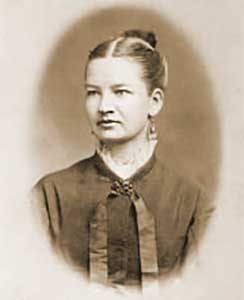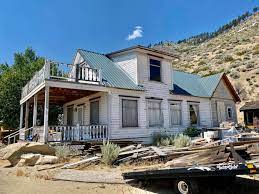
"Women with their marvelous perception of individuality would bring to the treatment of the sick a subtle divination – a tact in management of the patient’s mind, to which mend [sic] could never attain."
Excerpt from The Doctor Was a Woman, chapter titled, “Dr. Eliza Cook: First Licensed Doctor in Nevada." Used with permission from author Chris Enss and TwoDot Books. Images in the public domain.

Eliza Cook
First Licensed Woman Doctor in Nevada
“For forty years she practiced medicine in this valley, and many a man now with a family of his own recalls being summoned in the middle of the night to saddle his horse and go across the valley for Dr. Cook.”
Nevada State Journal, June 9, 1946
An advertisement that appeared in the May 5, 1892, edition of the Reno Gazette Journal caught the attention of many residents in the northern Nevada town. It read: “Dr. Eliza Cook may be consulted at her office in rooms 25 and 26 at the Golden Eagle Hotel between the hours of 9:30 to 11:30 A.M. and from 2 to 4 o’clock P.M.”i
The reason the advertisement drew so much attention was the fact a woman physician had posted it. The idea of a woman doctor was still a relatively new one in the Old West in the late 1800s. A female physician publicizing her services was also unique. Dr. Cook was confident her practice would benefit the community and was willing to risk criticism from those who believed the bold act was as out of place as a woman in the medical profession.ii
Eliza’s desire to become a doctor began when she was fourteen years old. She was a voracious reader, and one of her favorite books when she was young was of a country doctor and the individuals he helped. From that point on, she was consumed with the dream of studying medicine.iii
Eliza Cook was born in Salt Lake City, Utah, on February 5, 1856. Her parents, John and Margaretta, moved to America from England in the 1850s. Not long after her father passed away in 1870, Eliza, her mother, and sister relocated to Carson Valley. Nine years after the Cooks arrived in Nevada, Eliza was presented with an opportunity to be a part of the medical field. Dr. H. W. Smith, a prominent physician in Genoa, Nevada, hired her to help care for his wife. Mrs. Smith, who had just had a baby, was suffering with puerperal fever, a disease that primarily affects women within the first three days after childbirth. It progresses rapidly and causes acute symptoms of severe abdominal pain, fever, and debility. Dr. Smith was so impressed with Eliza’s natural ability and the way she tended to the patient he suggested she study with him as a preparation for college.iv
Eliza’s apprenticeship with Dr. Smith lasted six months. At the conclusion of her time at the practice, she entered [what would eventually be known as] Stanford Medical School. She graduated in 1884 with her Doctor of Medicine degree. In 1891, she continued her education by entering the Woman’s Medical College of Philadelphia. Her postgraduate work was done at an academy in New York.v
Eliza Cook returned to Carson Valley after completing her studies and hung out a shingle formally announcing there was a new doctor in town. She was the first licensed woman doctor in the state. Her career in the region spanned four decades. She looked after patients who had contracted scarlet fever, typhoid, and diphtheria. She delivered numerous infants, mended broken bones, and stitched dangerous wounds. The top buggy she drove to make house calls was always a welcomed sight.vi
Dr. Cook was a supporter of women’s right to vote and an ardent member of the Woman’s Christian Temperance Union. She served as the state president for the organization from 1896 to 1901. She was outspoken and believed the notion men should rule over women was unjust.vii

Dr. Cook's home
She never married and lived happily alone in a home she had built for herself in Genoa. She enjoyed gardening and reading. The articles she routinely read in Scientific Monthly, the Pathfinder, the New Republic, and Survey Graphic kept her up to date on political matters and advancements in medicine.viii
Not only was Dr. Cook a student of many medical journals; but she was a contributor. Eliza penned several articles about the medical profession and the need for more women to enter the field.ix One of Dr. Cook’s articles was reprinted in the October 14, 1895, edition of the Observer.x
“The college for the medical education of women founded by the Legislature of Pennsylvania was a triumphant [sic]. The act by which it was founded conferred upon it all the privileges enjoyed by any other medical school in the state. It was Elizabeth Blackwell who first received the degree of Doctor of Medicine at the Geneva College. She went on to pursue her medical studies in Paris and was a candidate for the professorship of surgery, and other ladies offered themselves to fill the other chairs.xi
“At first sight, this seemed an extraordinary proceeding and quite a startling novelty. But there remain sufficient grounds for women to pursue careers in medicine and succeed in the field. For one thing, it opens a new field for the employment of women profitably and usefully; and any enlargement of the field of honorable occupation for the sex tends to her own social advancement, as well as that of humankind. Looking at the profession of female doctor, “there is nothing unreasonable in it, but the contrary, however much it may be at variance with existing usages. In many of the diseases to which women are subject, the care of their own sex seems perfectly consistent with all notions of delicacy and modesty.xii
“Not half a century ago, women were very extensively, indeed almost exclusively, employed to attend the sex only under certain circumstances. There were some male doctors who were indignantly against the substitution of medical men in such cases, as a mark of our declining manners and morals. Women were then displaced because of their want of scientific culture, and the men took their place. Slowly, over time, women were offered the same degree of culture, making them equally competent to officiate in such cases as male surgeons.xiii
“There are now a growing number of women throughout the world in extensive practice, who have even been in difficult cases, called in by medical men themselves, in consultations. These ladies command a high degree of respect and maintain a high social status. Books such as the Moral History of Women by Earnest Legouve advocate for a wider sphere of operations for women in the field of medicine. He asked, ‘Why should not certain specialties of the medical art be accessible to women? Operative surgery, a science positive and material, requires boldness and of execution, a firmness of hand, a certain force of insensibility, which naturally excludes women from it; but medicine is a theoretical science, depending on observation; and who will contest the superiority of women as observers? As a practical science it depends upon the knowledge of individuals, and who understands so well as a woman the peculiarities of individual character? Women with their marvelous perception of individuality would bring to the treatment of the sick a subtle divination – a tact in management of the patient’s mind, to which mend [sic] could never attain.’xiv
Dr. Cook retired from practicing medicine in 1922. She died at her home in Carson Valley on October 2, 1947. She was laid to rest at the Mottsville Cemetery in Gardnerville, Nevada.xv
===============================================================
i Reno Gazette Journal, May 5, 1892
ii Nevada State Journal, June 9, 1946
iii Ibid., Reno Gazette Journal, March 27, 2008
iv Nevada State Journal, June 9, 1946, https://www.cambridge.org/core/journals/medical-history/article/epidemiology-of-puerperal-fever-the-contributions-of-alexander-gordon/C917A91D221BD13CEF6724018B316353
v Reno Gazette Journal, March 3, 1973, Nevada State Journal, June 9, 1946
vi Ibid., Reno Gazette Journal, March 3, 1973
vii Ibid., Reno Gazette Journal, March 27, 2008, Nevada State Journal, June 9, 1946
viii Ibid.
ix Ibid.
x The Observer, October 14, 1895
xi Ibid.
xii Ibid.
xiii Ibid.
xiv Ibid.
xv Reno Gazette Journal, October 3, 1947, www.ancestry.com/Nevada Death Certificates, 1911-1965 for Eliza Cook
=========================================================
HISTORICAL NONFICTION
Chris Enss
TwoDot
February 6, 2024
ISBN: 978-1493062928
Chris Enss is a New York Times bestselling author who has been writing about women of the Old West for more than thirty years. She has penned more than fifty published books on the subject. Her work has been honored with nine Will Rogers Medallion Awards, two Elmer Kelton Book Awards, an Oklahoma Center for the Book Award, three Foreword Review Magazine Book Awards, the Laura Downing Journalism Award, and a Willa Cather Award from Women Writing the West for scholarly nonfiction. Enss’s most recent works are The Doctor Was A Woman: Stories of the First Female Physicians on the Frontier, An Open Secret: The Story of Deadwood’s Most Notorious Bordellos, and Along Came a Cowgirl: Daring and Iconic Cowgirls of Rodeos and Wild West Shows.

